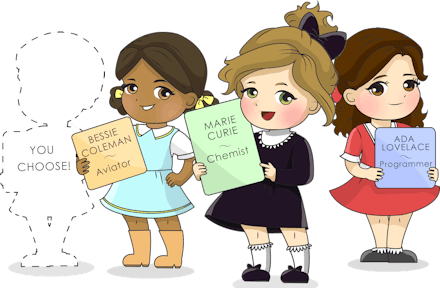Two Engineers Have Created the Doll Every Young Girl Should Be Playing With

Pink bows, Easy-Bake Ovens, Bridal Barbie.
Take one walk down a toy store aisle in the U.S. and you'll notice one striking trend: America's glaring double standard surrounding the toys we make for kids and the gender roles they teach.
But a couple of recent college grads are on a mission to change that. Their toy company, Miss Possible, sends a powerful message to young girls: Science, technology, engineering and mathematics are ready for more female pioneers.
It's the brainchild of Supriya Hobbs and Janna Eaves (pictured left), two former engineering students at the University of Illinois. They launched Miss Possible on Indiegogo in July and surpassed their $75,000 fundraising goal last Saturday. The first line of dolls, available in 2015, will feature two-time Nobel Prize winning chemist Marie Curie, high-flying aviator Bessie Coleman and the world's first computer programmer Ada Lovelace — pioneering women who are great role models for kids.
"I had my fair share of Barbies," Supriya, the daughter of two chemists, told Mic in an interview. "But I also had Legos and all sorts of things. I'm not saying do away with 'girly' stuff, but it's about balance."
It's no coincidence that Miss Possible is taking on the STEM fields first. Supriya and Eaves first bonded as two women engineering students who looked around their classes and questioned, "Where are all of the [other] women?!" They resolved to tackle the problem by empowering girls through play.
Once Supriya and Eaves overcame the challenges of juggling heavy course loads at the University of Illinois with launching a business, Miss Possible was born. In addition to being "just a doll," Miss Possible will feature apps to bring the dolls' work to life.
Image Credit: Miss Possible
Kids need options like Miss Possible because research indicates that toys impact children's behavior. They shape everything from children's self-esteem to the career choices they make in adulthood. According to U.K. retail group Argos, there is a clear correlation between how adults played as children and their current careers: More than 60% of adults working in design jobs, such as architects, enjoyed playing with building blocks, while 66% of those in math-related roles loved playing with puzzles as children. Yet every three seconds, another Barbie is bought. Ninety percent of girls ages 3-10 own at least one Barbie doll.
"One day, Janna and I were leading a workshop about invention and one girl – probably about 8 years old – was really excited about explosions!" Supriya writes on Miss Possible's Indiegogo page. "Literally EVERY suggestion she had involved some sort of exploding part. Later on, Janna had the opportunity to speak with her 1:1, and asked her 'What do you want to be when you grow up?' The answer? 'A fashion designer.'"
Image Credit: Miss Possible
Some big toy manufacturers — including companies like Hasbro — are noticing the demand for more options. Supriya is optimistic about the changes taking place in the market: "I think it's great that the [big manufacturers] are beginning to enter this space, as they have the capacity to reach a lot of kids. People care about showing girls something beyond just princesses and about using play as a learning opportunity. There's definitely room in the industry for more than one company to make toys that give kids positive messages," she told Mic.
If she has her way, Miss Possible will lead this charge. In addition to seeing Miss Possible dolls in big box stores, she and Janna dream about having a Miss Possible store with hands-on activities and demonstrations of how toys are made. Supriya said, "There are lots of opportunities and we're definitely dreaming big for Miss Possible!"
The next Ada Lovelace or Bessie Coleman might be a girl who grows up playing with them today.
This story is a collaboration between Mic's branded content team and Cole Haan; it was not written or created by Mic's editorial staff. To learn more, visit our Branded Content FAQS page.